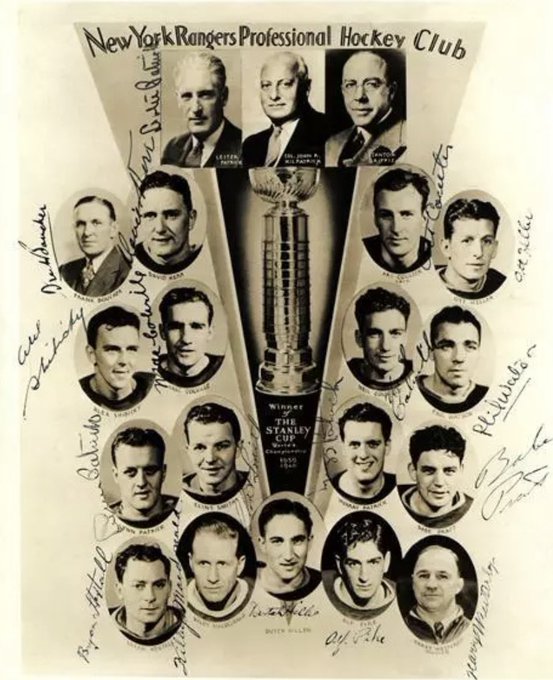
On Friday, August 9th, I uploaded four new blogs to BlueCollarBlueShirts.com. Make sure to check them all out. Here they are:
In August of 2019, which is when I’m writing these words, New York Rangers news is kind of light this week. Therefore, I wanted to talk about something different in this blog. As you know, I’m a huge proponent of New York Rangers history. This isn’t a knock on anyone else, but from what I read, this is the only Rangers blog that goes out of its way to talk about Rangers history whenever it can. Even when you look on the social media, you have Ranger bloggers and paid Ranger reporters replying with the word “WHO?” when you talk about Chuck Rayner. Even worse, one Ranger reporter on twitter admitted he didn’t even know who Davey Kerr was. Millennials.
I know everyone lives in the now, but one can’t forget history. After all, I would reckon to say that most of us became Ranger fans because our parents were Ranger fans. And before that, our grandparents were Ranger fans. I know that’s the way it worked for me.
What bothers me worse than Henrik Lundqvist’s contract, is the way the Rangers themselves ignore the first 40 years of their existence. Sure, the 1928, 1933 and 1940 Stanley Cup Banners hang in the rafters of MSG, but it comes off as purely decorative. When you look at the rafters of MSG, cupless Rangers like the GAG line, Harry Howell & Andy Bathgate all have their place. That’s fine and dandy. However, in the same vein, how do you ignore guys like Frank Boucher, winner of 3 Cups? (2 as a player, one as a coach.) How do you ignore the first captain in Bill Cook? (2 Cups) How do you ignore the HOF defenseman in Ivan “Ching” Johnson, another two-time Cup winner? And for the purpose of this blog, how do you ignore some of the all-time Ranger greats and Hall of Famers, the players that won the Cup in 1940?
If you’re new here – check the archives. I’ve been beating the Frank Boucher drum for many years now, and have had the fortune of talking to his living relatives. I even visited his grave.
I’ve gotten some inane criticism from other Ranger fans about how I spend too much time talking about the history of the franchise and how these people only want to read about the “now”. Of course, I don’t care what others think. This is my blog and I’ll blog if I want to! And personally, I rather read up on Art Coulter than read about what K’Andre Miller is doing in college!
The biggest problem, in regards to when I go back and talk Ranger history, is that these players, the writers who covered these players (sans Stan Fischler, who has been a fountain of information for me) and the fans of these players, are that most of these people are no longer alive. These players, these teams, just don’t have a voice. Yeah, I’m known as the guy who doesn’t like Lundqvist and his contract, but to me, while my criticisms are valid, sometimes on social media I just rile people up for the laughs. When it comes down to it, I rather be known as the guy trying to bring these HOF Rangers back to life.
After all – who else will talk about these guys? I mean, here in August of 2019, you got the plagiarizing writer from WFAN still trying to defend Henrik Lundqvist. Let’s face it, if you have to keep constantly defending a guy, he’s not an all-time great. No one questions the careers of Sawchuk, Plante, Brodeur, Roy, Hall, etc. When you have to keep fawning praise and defending a guy, chances are, he’s not that great. I mean listen, I loved Don Mattingly growing up, but to call him the best first basemen in baseball or in Yankees history, well that is just wrong. The same applies to Lundqvist when compared to other goalies, both non-Ranger and Ranger goalies alike.
When you talk about Ranger goalies, and I’ve done blogs on this before (check the archives) the three names that always pop up are Giacomin, Richter and Lundqvist. Of course, there’s never anyone defending or making a case for Chuck Rayner, because the people who saw him, and the people who played with him, have largely passed on. All Rayner did was take one of the worst teams in Rangers history, during the post WWII era, and got them to a Game 7 double OT in the 1950 SCF. Keep in mind, this is when the Rangers didn’t play home SCF games, as the MSG owners wanted the more lucrative and profitable circus in town. Instead, the Rangers always played their SCF and playoff games on the road, either in neutral sites, or in the case of the 1950 SCF, at their opponent’s barn. And while this isn’t another blog on Rayner, not only did Rayner go further than Lundqvist ever did, he won the damn Hart Trophy too. (Furthermore, if Rayner played under the parameters that Lundqvist did when he won his Vezina, Rayner would’ve won the Vezina in that 1949-1950 season as well.)

While the Rangers franchise, in the present day, will never stop talking about 1994, the truth of the matter is that the 1940 Rangers may have been more dominant in their time. Sure, it’s tough to compare eras, but you’re talking about a team that produced a higher percentage of Hall of Famers than the 1994 Rangers.
Let’s take a look at the club.
At General Manager, was the silver fox himself, in a one Lester Patrick. How Lester Patrick is ignored by the Rangers to this day, I’ll never know. The story of him playing in the 1928 SCF is legend alone. As General Manager, he won three Cups with the Rangers. During those two of those runs, he also was the man behind the bench. Patrick, who is in many hockey and sports hall of fames, should’ve been one of the first people to have his name in the rafters of MSG.
At Head Coach, you had Frank Boucher, who played under Lester Patrick during the 1928 and 1933 SCF victories. I’ve talked about Boucher non-stop on this blog and even have a tab at the top of this site dedicated to him. I don’t have to go into my greatest hits here. All I will say, is that in his 1975 memoir, “When The Rangers Were Young”, Boucher called the 1940 Stanley Cup championship team the best Rangers team in the 50 years of Rangers hockey that he saw. Boucher’s opinion carries a lot of weight with me, which is why I’m doing this blog on the 1940 Rangers, rather than talking about the 1928 or 1933 teams. (That said, maybe one day I will!)
In goal, you had Davey Kerr, who won the Vezina that season and played in every regular season and playoff game during the 1939-1940 campaign. To this day, Kerr is not in the HOF, because he had a short career (7 years with the Rangers) and retired at the young age of 31. However, during the 1930’s and up until his retirement in 1941, he only had one losing season with the Rangers. Kerr was in the NHL for 11 years, and had only one losing season. That’s impressive, considering Kerr spent the majority of his career playing in the most southern city in the NHL, in a league where playing in NY was a major disadvantage. (In these days, teams had rights to any player within a 100 mile radius. Obviously, this favored the Canadian teams and Detroit, who play on the US-Canada border, as Detroit is a stone’s throw from Windsor.)
The star forward for the Rangers during the 1939-1940 season was Bryan Hextall, who led the league in scoring that season. In the 1940 SCF, Hextall recorded a hat trick against the Leafs and would also score the overtime Cup winning goal in Game 6. Again, this is when the Rangers played every SCF game on the road. Hextall, because of his life-long career on the Rangers, would enter the HOF in 1969.

The Rangers had two different brother duos on their 1940 Championship team, in the Colville & Patrick brothers. Obviously, there was some nepotism when the Rangers signed Murray “Muzz” Patrick & Lynn Patrick. However, it was Frank Boucher, who told Lester Patrick that the two kids were gamers and would easily assimilate to the team.
Of the brothers, Lynn Patrick had more NHL success and would be inducted into the HOF, posthumously, in 1980. Both Patrick brothers would serve for the US during World War II, having their playing days cut short. Lynn would do two years for the military, while brother Muzz did four years. Muzz would later make his name known as the GM of the Rangers, during some very lean years.
Lynn, who played left wing, put up 28 points in the 48 game regular season. Muzz, a defenseman, logged 6 points in a league where you really didn’t have the offensive-defenseman that you see today, or that would later become the rage during the Bobby Orr era.
The Colville Brothers, Neil & Mac, unlike the Patrick brothers, were both wingers. They played on the same line, usually flanked by Alex Shibicky. Like many during this time, after the 1940 Stanley Cup win, the brothers would serve in the military (Canadian) during World War II. Ironically, when they came back, the two were no longer forwards. Being older and not as quick as they were pre-War, both Colville’s manned the blue line for the Rangers.
During the 1939-1940 season, Neil Colville was one point shy of being the team leader in points, finishing with 38, only second to Hextall’s 39 points. Brother Mac finished with 21 points. Like the Patrick brothers, only one brother made the HOF, as Neil Colville was inducted into the HOF in 1967.
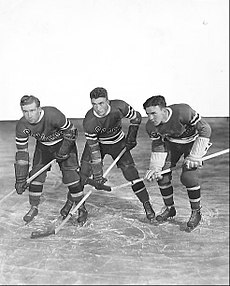
Alex Shibicky, the other winger of the Colville line, put up 32 points during the season, which was good for fourth overall on the team. While not a hall of famer; like many of his peers during this era, his career was cut short because of World War II. And really, when you go back in time, how many more Cups would’ve the Rangers won with this core of guys if it wasn’t for World War II? Sadly, we will never know.
Ott Heller, who is also deserving of a banner at MSG, starred as a Top 2 defenseman for the Rangers. Later on in his career, he would wear the “C” for the team. Born as Ehrhardt Heller, Ott Heller won his second Cup with the Rangers in 1940. Previously, Ott was part of the 1933 Championship team.
In something I didn’t know until today, after talking to relative of Ott Heller’s, Ott Heller actually had a brother that could’ve been a Ranger too. Unfortunately for the other Heller, he lost his eye due to an errant skate blade.
If you look at the course of Rangers history, the Rangers loved signing brother duos for several reasons. One main reason, aside from talent, is that when these players signed with the Rangers, for many, they were in a new world. Most of these players were all Canadian and didn’t know America. Additionally, in this era, NYC was, just like it is today, one of the most busiest cities in the world. By signing brothers, the Rangers were able to give their players a companion, a friend so to speak, as they entered this new journey in a new big city together.
Ott Heller, a life-long Ranger, finished up with 19 points during the 1939-1940 season. He also tallied three assists in the 1940 playoffs.

Art Coulter, like many on the team, would serve in the military (Coast Guard) during World War II. He also would be inducted into the HOF in 1974. Coulter, who split his NHL career between Chicago and New York, had the distinct honor of becoming captain of the team after the retirement of the legendary Bill Cook.
Coulter was another key piece of the Rangers blue line during this Cup run. Coulter was a true defensive defenseman and was usually assigned to the star player of the opposing team.
To me, Phil Watson is the most intriguing part of the 1939-1940 Rangers, because of his later years as the head coach of the Rangers. As mentioned on previous blogs, I’ve read nothing but negativity about Watson. Even Stan Fischler, the most positive man around, had nothing nice to say about Watson when I asked Stan about him.
Watson, a right winger (position wise, and maybe politically!) led the team with 28 assists. In the playoffs, he & Neil Colville logged a team high 9 points in the 12 playoff games played. It’s truly a shame Watson never wrote a book or did interviews after his NHL career was over. From all reports, his only friend was Muzz Patrick.
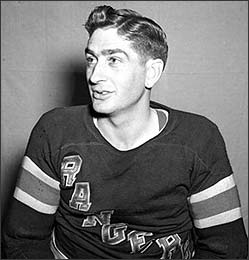
Alf Pike, the favorite Ranger of Blueshirt Underground Radio host Jim Schmiedeberg, made his NHL debut during the 1939-1940 season. Pike, known as “The Embalmer”, due to his off-season work as a mortician, (Imagine if he was around today with that nickname!) Pike also lost parts of his career due to World War II.
Pike, who played on the third line, finished with 17 regular season points and added four more points in the playoffs. Not shabby for a rookie!
Clint Smith, a linemate of Pike, had the distinction of being the last living Ranger from that 1940 Stanley Cup Championship team. Smith passed away on May 19, 2009, at the age of 95. Smith was a clean player, and would win two Lady Byng Trophies during his career. While Smith wasn’t the best player on the team, he was able to contribute when necessary.

James “Kilby” MacDonald isn’t a household name today. While winning the Calder Trophy in 1940, he was barely a household name in his time. Again, like many, his career was cut short because of World War II. Even with the war, MacDonald spent time in the AHL after 1940 and before he went to serve in the Montreal army. MacDonald, a left-winger, scored 28 points during the season, but would only add 2 points in the playoffs.

Babe Pratt, another Hall of Famer (inducted in 1966) had an interesting life. In fact, he was the Pete Rose of his time, as he would later get caught betting on games. Pratt would also win the Hart Trophy in 1944. (And yes, to be fair, the league was decimated and a shell of itself at this time, because of World War II.)
A left-handed defenseman, the Rangers really made a big play for Pratt when they signed him. Pratt wouldn’t disappoint, as logged 17 points in the regular season and four more in the playoffs. 1940 wasn’t Pratt’s peak, as the best was yet to come for the eventual Hall of Famer. Fortunately for Pratt, he didn’t have to serve and was able to continue his hockey career during WWII.
Wilbert “Dutch” Hiller, was a third line winger during the 1940 Cup run. Hiller had a monster season, as he collected 31 points in the regular season and six more points in the playoffs. A native of hockeytown Kitchner, Ontario, Hiller logged the assist on Hextall’s Game 6 Cup winning goal against the Leafs.
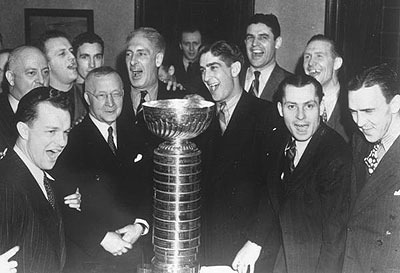
Now, when you look at all these legendary players and men who gave their lives to defend their country during World War II, wouldn’t you think the Rangers would honor these guys? For whatever reason, the Rangers have ignored everyone from this team.
As talked about previously, of the Original 6 teams, the Rangers do the worst job when it comes to honoring & promoting their history. The franchise ignore large chunks of it. As small as having a statue to honor their greats, the Rangers are the only Original 6 team to not have a statue or a place to honor their legends. Conversely, a team like Tampa Bay, who has 25% of the history the Rangers have, have two statues, with a third coming.
Personally, and I have no way of proving this, I think the Rangers have frowned on the great 1940 team. In my opinion, part of this is because it took the Rangers 54 years to win another Stanley Cup after the 1940 championship. In other words, the year 1940 brings up negative emotions. We all know about the “19-40” chant. Unfortunately, because the Rangers failed for so many years, the Rangers would rather celebrate 1994 as their grand coronation, and treat 1940 as bad vibes.
The “Curse of 1940” has two roots. One root is Red Dutton, the ex-player/coach/GM of the then-Ranger rivals, the NY Americans. (The Islanders or Devils of their time.) After being screwed over by MSG, Red Dutton swore that the Rangers would never win a Cup in his lifetime. Red was right, as he passed away in 1987, at the age of 88 years old.
The other root of the curse is a self-inflicted one. After paying off their mortgage of Madison Square Garden, the Rangers, led by General Kilpatrick, the then owner of the Rangers, burned the mortgage in the Stanley Cup. To me, I agree with the 1940 team – this was a symbolic act of celebration and achievement. However, to the hockey gods, maybe this was an act of sacrilege.
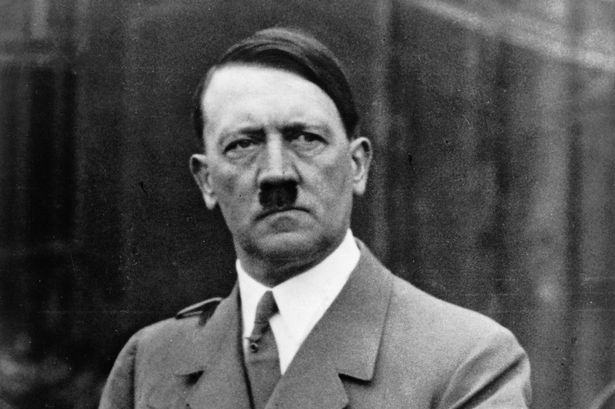
When you look at the Rangers and “The Curse of 1940”, there is logic there to explain the Rangers failures to win the Cup. Obviously, World War II affected the Rangers more than any other team in the league. As mentioned, before the Great Expansion of 1967, franchises/clubs/teams had draft rights based on their location. At the time, there weren’t many home grown hockey players in the NYC area. While many teams lost players, other teams were able to refill their rosters quickly and better than the Rangers could. It would take the Rangers years to put a competitive team on the ice.
In 1950, because of one of the biggest carry jobs in NHL history by goalie Chuck Rayner, the Rangers would make the SCF again, losing in a double OT Game 7. Of course, during this era, MSG elected to have the circus rather than Ranger playoff games in town, thus hurting the Rangers chances to win the Cup. It wouldn’t be until Emile Francis took over in 1965, that the Rangers would have home Stanley Cup playoff games again.
During the Rangers best chances to win the Cup, the Rangers would lose to a stacked Bruins team during the 1972 SCF. In 1979, the Rangers upset their way into the SCF, where they ran into the end of the Montreal dynasty.
With the Islanders (ugh) and Oilers dominating the 1980’s, it wouldn’t be until 1994 where the Rangers won the Cup for the first time in 54 years. The number “1940” no longer represented a championship or great times. It invoked misery. By winning the Cup in 1994, the Rangers “conquered” 1940. Unfortunately, because the Rangers spit in the face of their own history, the Rangers have ignored 1940 ever since.
It was the purpose of this blog to remember the great 1940 team and bring these old Ranger names back to life. I hope you enjoyed it.
As always, thanks for reading and…
“LET’S GO RANGERS!”
Sean McCaffrey
BULLSMC@aol.com
@NYCTHEMIC on tweeter






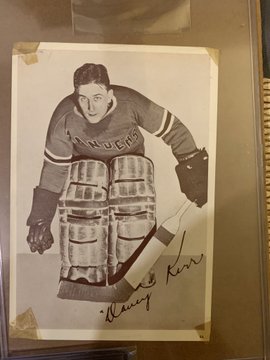
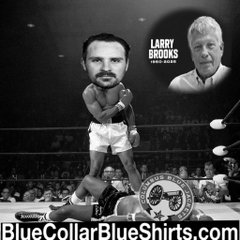
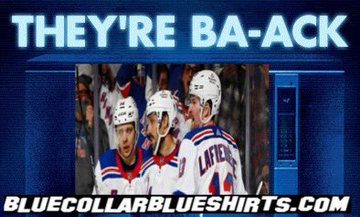
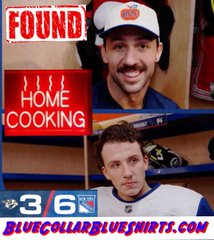
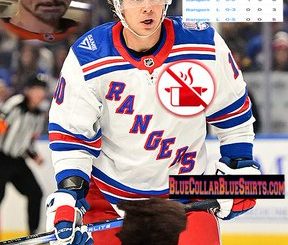
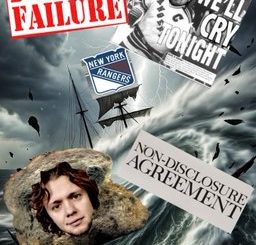

Great article Sean. I also have complained to other “fans” of the Rangers how they completely ignore their history. The Rangers were essentially the top franchise in the league before the original six started yet no one has an idea. Sadly, all we will ever here is the GAG (barely), 1994, and Mr. Cups in net currently.
Thanks Fabio, I appreciate it. When the team doesn’t promote their history, the common fan isn’t going to go out and seek it either.